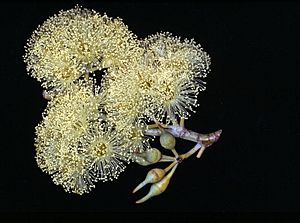Inland red mallee facts for kids
The inland red mallee (scientific name: Eucalyptus socialis subsp. eucentrica) is a special type of eucalyptus tree found only in inland Australia. It's called a "mallee" because it usually has many stems growing from the ground. This plant often has rough bark at the bottom of its trunk, but smooth bark higher up. Its leaves are shaped like a spear. It produces pale creamy yellow flowers from buds that grow in small groups. After flowering, it forms woody, barrel-shaped fruits.
Quick facts for kids Inland red mallee |
|
|---|---|
 |
|
| Flower buds and flowers of subspecies eucentrica | |
| Scientific classification |
|
| Kingdom: | Plantae |
| Clade: | Tracheophytes |
| Clade: | Angiosperms |
| Clade: | Eudicots |
| Clade: | Rosids |
| Order: | Myrtales |
| Family: | Myrtaceae |
| Genus: | Eucalyptus |
| Species: | |
| Subspecies: |
E. s. subsp. eucentrica
|
| Trinomial name | |
| Eucalyptus socialis subsp. eucentrica (L.A.S.Johnson & K.D.Hill) D.Nicolle
|
|
| Synonyms | |
|
|
What it Looks Like
The inland red mallee is a type of eucalyptus plant. It usually grows like a shrub or small tree, reaching about 3 to 10 meters (10 to 33 feet) tall. It has a special woody swelling at its base called a lignotuber. This helps the plant regrow after fires.
The bark at the bottom of the trunk is often rough and flaky. Higher up, the bark is smooth and can be tan or grey. Its adult leaves are a dull bluish-green on both sides. They are shaped like a spear, about 7 to 12.5 centimeters (2.8 to 4.9 inches) long and 1.5 to 2.6 centimeters (0.6 to 1 inch) wide. These leaves have a stalk, which is called a petiole.
The small branches and flower buds are covered in a waxy layer. The flower buds grow in the axils (the angle between a leaf and a stem) of the leaves. They usually appear in groups of 7 to 11. Each group of buds sits on a stalk called a peduncle, which is about 4 to 18 millimeters (0.16 to 0.71 inches) long. Each individual bud has its own tiny stalk, called a pedicel, about 2 to 8 millimeters (0.08 to 0.31 inches) long.
When the buds are ready to open, they are about 10 to 13 millimeters (0.39 to 0.51 inches) long. They have a horn-shaped cap, called an operculum, which is longer than the base of the flower (the floral cup). The flowers are a pale creamy yellow color. After the flowers bloom, they turn into woody fruits. These fruits are shaped like a barrel, an urn, or a sphere. They are about 5 to 8 millimeters (0.2 to 0.31 inches) long.
How it was Named
In 1991, two botanists, Lawrie Johnson and Ken Hill, officially described this plant for the first time. They called it Eucalyptus eucentrica. They published their description in a science journal called Telopea. They found the plant near Erldunda in the Northern Territory.
Later, in 2005, another botanist named Dean Nicolle decided that Eucalyptus eucentrica was actually a type of Eucalyptus socialis. So, he changed its name to E. socialis subsp. eucentrica. He published this change in the journal Australian Systematic Botany. This new name has been accepted by the Australian Plant Census, which keeps track of all Australian plants.
The name eucentrica comes from ancient Greek words. "Eu" means "well" and "centrica" means "of the center." This name refers to how widely this plant is found in the middle parts of Australia.
Where it Grows
The inland red mallee grows in areas called mallee woodlands. These are places where many mallee trees grow together. It often grows in rocky areas and alongside other types of eucalyptus trees. Some of these include E. gamophylla and E. oxymitra.
You can find this plant in many places across inland Australia. It grows from the Gascoyne region in Western Australia, through the southern Northern Territory, and into north-western South Australia. There are also some smaller groups of these plants found in central Queensland.
Conservation Status
The Western Australian Government's Department of Parks and Wildlife has classified this mallee subspecies as "not threatened." This means it is not currently at risk of disappearing.

